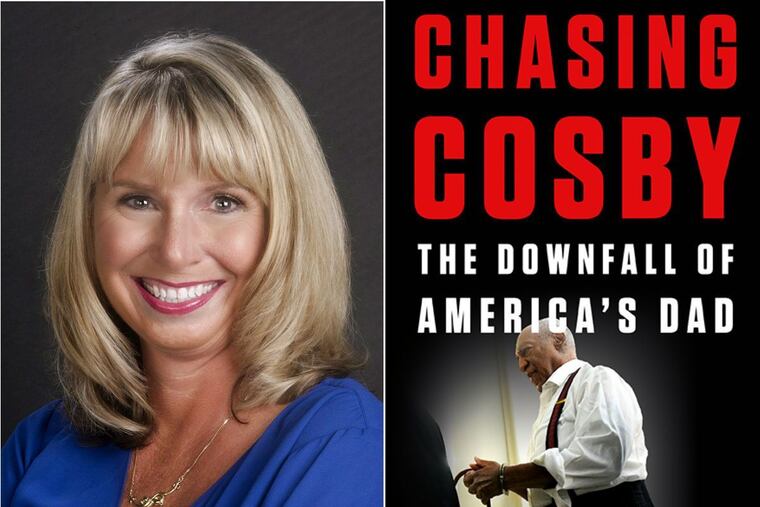‘Chasing Cosby’ by Nicole Weisensee Egan: The lonely work of reporting on the downfall of a pop-culture icon
Former Daily News reporter Egan followed the Bill Cosby case for years. It was lonely work, undermined by experts, fellow journalists, and academics, none of whom wanted to believe in Cosby's guilt. Her book is a vivid, often personal look at both his court case and her experience covering it.

Chasing Cosby
The Downfall of America’s Dad
By Nicole Weisensee Egan
Seal Press. 320 pp. $28
Reviewed by Jessica M. Goldstein
Bill Cosby was raised in a North Philadelphia housing project, spent the prime of his life as one of the most admired and adored performers in Hollywood, and currently resides in SCI Phoenix, a Pennsylvania state penitentiary where he is serving three to 10 years for aggravated indecent assault.
I covered both of Cosby’s criminal trials (the first of which ended in a mistrial) for ThinkProgress, seeing up close a true rarity in American life: a man being brought to justice for an act of sexual violence. That Cosby was an exceptionally famous and wealthy man only made this more extraordinary. A dozen or so of Cosby’s accusers also attended the trials, six of whom testified for the prosecution.
After nearly five years on the Cosby beat, I thought I knew the story to its bones. But Nicole Weisensee Egan’s expertise in Chasing Cosby is formidable, and her book is worthwhile for anyone hoping to understand the Cosby case in full. She was an investigative reporter at the Philadelphia Daily News when Andrea Constand’s allegations broke in 2005, and she continued to cover Cosby at People and the Daily Beast. It seems there is no relevant document she hasn’t read, no critical character she neglected to interview. Chasing Cosby chronicles her experience following a case that, for years, most people preferred to ignore. In clear, vivid prose, she illuminates how a beloved star was exposed as a violent predator, and how Cosby’s conviction became the first of the #MeToo era.
Egan deftly balances a play by play of the criminal proceedings with a methodical explanation of her reporting, gamely sharing her personal relationship to both. Specialists on everything from victim behavior to forensic toxicology contextualize Egan’s findings. She raises zoom-out questions that Cosby’s conviction alone doesn’t answer, about wealth, race (“Did our nation’s shameful history of false sexual assault accusations against African American men become a cloak he wrapped around himself so he wouldn’t get caught?”), the criminal justice system, and “the dangers of deifying celebrities.” Egan’s willingness to share her human connection to her work makes her writing resonate with a greater power.
Egan came to the case as a Cliff Huxtable fan. The Cosby Show debuted when she was a high school senior, the same year her older brother died, “and watching the show gave me an escape out of my own, fraught home and into the cozy normalcy of a family not traumatized by death.” But the more she dug into Constand’s allegation that Cosby — a man Constand considered a mentor, not to mention a major donor and member of the board of trustees at her employer, Temple University — had drugged and sexually assaulted her at his home in Cheltenham, the more “the validity of the charges came to light.”
Egan’s was a lonely reporting effort. Until October 2014, when Hannibal Buress’ stand-up set at the Trocadero mentioning Cosby rape allegations went viral, Egan practically had the Cosby beat to herself. Nobody wanted to believe Cosby could be a serial abuser, even though his predilection for drugging women was apparently an open secret in the entertainment industry. Constand’s, too, was an isolating journey: Of the 60-plus women who eventually came forward to accuse Cosby of sexual misconduct, only Constand had a claim that was within her state’s statute of limitations, not only when she first reported it to the police but also when the Montgomery County District Attorney’s Office approached her about reopening the case in 2015.
As Egan pursued the Cosby story, she found enemies in unexpected places. That she faced threats from Cosby’s camp is alarming if not surprising; that other journalists undermined her work is more disconcerting. She details her infuriating struggle to get journalism experts to see the accounts of Cosby’s accusers as “legitimate” enough to merit news coverage, and she is undermined by media professors and pundits who say stories about allegations witnessed only by the two involved parties (so, the vast majority of sex crimes) could never pass journalistic muster.
Some of the most damaging information involves Bruce Castor, the Montgomery County district attorney at the time, who declined to prosecute Cosby in 2005. Though Castor later tried to win back his D.A. seat with the campaign promise that he would get Cosby next time around (he lost to Kevin Steele), Egan’s reporting reveals a man who never took Constand’s allegations seriously and instead went out of his way to protect Cosby.
In some ways, the pre-2017 world Egan describes already feels carbon-dated. Constand went to the police a year before Tarana Burke began the Me Too movement and 12 years before Burke’s rallying cry became a hashtag that galvanized an unprecedented and continuing reckoning with sexual violence. In Chasing Cosby, Egan reminds readers how new, unusual, and remarkable it is that the Me Too movement is happening at all. Her reporting is a reminder that we’re living through a historical anomaly that, without the courage and fortitude of Constand and her sister survivors, may not have come to pass.
Jessica M. Goldstein, culture editor of ThinkProgress, wrote this review for the Washington Post.